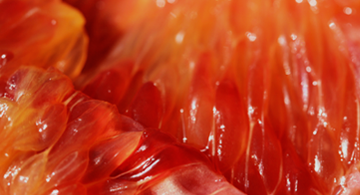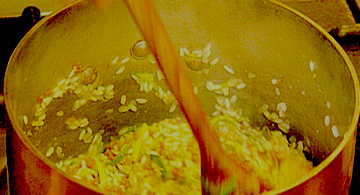
Tuscan Beef Sugo with Porcini and Cornmeal Polenta is a quintessential beef ragù of Tuscany. While many Italian sauces are called sugo, this particular sugo recipe is ragù. Usually meat stock or broth, chopped tomatoes or tomato puree, is flavored with finely chopped vegetables and simmered to a consistency similar to thick soup or thin sauce for sugo. Adding chunky bits of meat and slowly cooking until thickened and mouth-wateringly tender transforms this sugo into ragù.
Often soffritto and meat are cooked longer in Tuscany for sugo than in other Italian regions. Edges of the vegetables and meat become brown, not burnt, as they caramelize. This long cooking provides depth of meaty flavor. Commonly-used liquids when cooking many Tuscan recipes is water, or water with a small volume of broth which is included in this recipe. It provides a base for the simmering ingredients to create a unique rich broth during cooking. Tuscan Beef Sugo is chunky like ragù, cooked like ragù, and lovingly presents Chianina beef for the prized meat it is.
Of Italian origin, La Chianina is Tuscany’s pride-and-joy, being one of the oldest cattle breeds in the world. Perhaps you’ve seen them grazing in pasture driving through the countryside. They are unmistakable in their gorgeous creamy white or beige coats with pronounced crest above their shoulders. Majestic in every sense, they exude a gentle contented demeanor that produces superior flavor and tender meat. It is Chianina beef that makes this sugo so special, and is the same used for the famous Fiorentina steak, Bistecca alla Fiorentina, so I call this sugo a steak-lover’s ragù.
Chef's Tips:
*Select the best beef you can find, but this does not mean purchase beef with the highest price tag! Make sure half of the beef quantity is really good steak so your sugo asserts its flavor because when combined with grains this flavor diminishes. Don’t skip on quality. I love hanger steak, skirt steak, tri-tip, flatiron, or sirloin tip known as bavette, with intense beefy flavor for this rich Sugo di Manzo Toscano – it is a winning combination!
* Tuscan Beef Sugo with Porcini: Porcini mushrooms are fabulous with this sugo. Add a few fresh porcini, or those previously frozen and thawed, or dried sliced porcini reconstituted in cool water. Clean well, drain if needed, then chop. Add when reheating sugo.
* Brown the meat and saute the soffritto on your cook top. Cover with a pierced foil sheet. Continue cooking in a preheated oven for 1 1/2 to 2 hours. Make one day in advance of serving. Tuscan Beef Sugo tastes equally delicious served with cornmeal polenta, grains, and pasta.
Cooking time is 2 1/2 to 3 hours. Makes 4 cups (946 ml) sugo.
4 to 6 servings
Tuscan Beef Sugo – Browning the Meat: Divide into 3 batches, about 9 to 10 minutes per batch
4 tablespoons (59 ml) extra-virgin olive oil, divided
8 ounces (227 g) hanger steak or other flavorful cut of beef steak, coarsely ground
8 ounces (227 g) sirloin steak tips or bavette, coarsely ground
8 ounces (227 g) fresh Italian pork sausage with fennel seeds, casings removed (2 links)
Salt to taste
Soffritto:
2 tablespoons (30 ml) extra-virgin olive oil
1 medium celery stalk, finely chopped
1/4 small red onion, finely chopped
1 ounce (28 g) prosciutto crudo, sweet pancetta, or rigatino, finely chopped (2 thin slices)
2 small garlic cloves, whole and removed later, or 1 clove finely chopped or grated, or to taste
1 tablespoon (15 ml) tomato concentrate
2 fresh rosemary sprigs
1 dried hot red chili pepper or generous pinch of ground cayenne red pepper, optional
Few wild fennel seeds to taste, optional
– add browned beef and sausage –
1 cup (8 ounces or 237 ml) beef broth, preferably homemade, or water
1/2 cup (4 ounces or 118 ml) Italian medium-body non-tannic red wine, such as Sangiovese
1 14.11-ounces (400 ml) can peeled, whole San Marzano, Roma, or plum tomatoes (1 cup or 237 ml volume tomatoes with canned juice)
2 1/2 cups (20 ounces or 591 ml) water
Porcini: Optional. Add later when reheating sugo
4 whole medium fresh or frozen and thawed porcini, cleaned, sliced
OR 2 ounces (1 cup dried slices or 57 g) per serving dried porcini mushroom slices, reconstituted in cool water, drained, cleaned
Ovenproof pot
Pierced foil sheet as cartoccio
Yellow Cornmeal Polenta:
4 cups (946 ml) water
Extra water as needed
1 tablespoon (14 g) unsalted butter
Salt to taste
2/3 cup coarse yellow polenta (4 ounces or 113 g)
1/3 cup fine yellow polenta (2 ounces or 57 g)
Recommended Cheese Topping: Freshly grated aged Caciotta di Pecora or aged Parmigiano-Reggiano cheese.
1. Browning Meat and Soffritto: This step takes 30 minutes. Divide the ground beef and sausage into three separate and equal batches. Saute each batch separately increasing rich flavor.
Pour 2 tablespoons (30 ml) oil into pot. Over medium heat, add the first batch of ground beef. Lightly salt the beef to extract its juices to begin caramelizing now. Saute until browned at the edges, about 9 to 10 minutes. (There will be a crackling/sizzling sound. Lightly browned pieces start popping up and sometimes pop out of the pan. Adjust the heat as needed to prevent burning.)
Transfer this to a bowl to catch juices. Pour in 2 tablespoons (30 ml) water to deglaze the pot. Immediately the liquid sizzles and steams, scrape the bottom of the pan with a heatproof spatula releasing caramelized bits. Turn off the heat. Pour the bits with juice over the sauteed ground meat. Repeat two more times adding 1 tablespoon (15 ml) oil each time for sauteing.
Chef’s Tip: Since the soffritto and meat are cooked longer for this Tuscan sugo than many other sugo or ragù recipes, watch carefully and stir often. The oil bubbles as the soffritto cooks. Browned caramelized juices accumulate on the bottom of the pot during sautéing. If they look like they might burn, add 2 spoons of water, which evaporate quickly, but temporarily cool the bottom and prevent burning. (If oil or fat is added instead of water, the meat will toughen and fry.)
2. This step takes about 30 minutes. Pour out any rendered fat and discard, do not wash the pot. Pour 2 tablespoons (30 ml) oil into the pot. Over low heat, saute the celery and onion until beginning to barely soften, about 5 minutes. Add the chopped prosciutto crudo, sweet pancetta, or rigatino and saute over low heat until fragrant and beginning to lightly brown at the edges, about 5 minutes. Add the garlic and tomato concentrate and stir. Add the rosemary, chili pepper, wild fennel seeds if using, and stir. Increase the heat to medium. Add the browned beef and sausage with accumulated juices and stir. Pour in the beef broth (or water). Cook for several minutes to reduce the beef broth by about 50% to concentrate its flavor. Increase the heat to high. Pour in the wine and reduce by half volume without stirring, cooking for 2 minutes. Add tomatoes with their juice, water, and salt to taste. Bring to a rolling boil. Remove from the cooktop.
3. Preheat the oven to 350 F/177 C/Gas Mark 4: Oven time is 1 1/2 to 2 hours. Partially cover the pot with its lid or foil sheet pierced using sharp tip of a knife so steam is released during cooking for the first hour. Place the pot on a baking sheet in the center of the preheated oven. After 1 hour, remove the pot from the oven. Stir the sugo to equally distribute for even cooking. Taste. The beef should be tender but not falling apart. If more salt is needed, add now and stir in.
If the sugo is thickening at this point but there is considerable liquid, remove the lid and put back into the oven for 1/2 hour. OR If the sugo is thickened, with not that much liquid, partially cover and put back into the oven for 1/2 hour. During this time, check the sugo for tenderness and remove at any point OR continue cooking up to another 1/2 hour for a total of 2 hours. The sugo should be thick with fork-tender meat. There should be about 1 cup (237 ml) liquid remaining to toss with pasta or pour over polenta. Remove from the oven. Remove the rosemary stalks, and whole chili pepper, and discard.
Leave rendered fat on the surface to seal in flavor. Cool completely, cover well, and refrigerate for 1 to 2 days.
When ready to serve, remove the sugo from the refrigerator and immediately remove the layer of rendered fat while cold so it is easy to lift off, discard the fat. This sugo may look firm due to gelatin released during cooking. Once reheated, it liquefies and is positively wonderful!
Preparing the Porcini: Optional. Add to the sugo during reheating
Fresh Porcini: Clean by brushing away debris. Under cool running water, quickly rinse if needed. If “amici” might be an issue, put the fresh porcini into the freezer for about 20 minutes. Amici tend to flee the scene, and pop out. Use a vegetable peeler to remove the thin outer coating for the stem if needed. Coarsely chop.
Frozen Porcini: Choose stems when possible because they are firmer textured when thawed and release less porcini water. Thaw, then slice or coarsely chop. Stir these into the sugo when warming so you can taste their delicate flavor.
Dried Porcini: Soak in cool water for about 20 minutes to reconstitute and soften. Remove porcini from water, feel along the edges and remove any tough bits or grit, then coarsely chop and add to the sugo. Taste the porcini water: If it is sweet you can add it to the sugo or reserve for another use, strain before using; if bitter, discard.
4. Making the Cornmeal Polenta: In a medium-sized saucepan over high heat, bring water, butter and salt to a boil. (Have an extra 1/2 cup (118 ml) water on hand to add to cooking polenta if it thickens too much.) In a slow steady stream, pour in both coarse and fine polenta simultaneously, continuously stirring with a large whisk, heat-resistant spatula, or wooden spoon.
Decrease heat to low and simmer the polenta until thoroughly cooked, stirring often. Use a spatula or spoon to scrape the sides and bottom of the saucepan to prevent burning the polenta. Steam will rise during cooking and occasionally polenta goes “pop!” from pressure building up so be careful not to get burned. Timing for this quantity is approximately 35 to 45 minutes or more for regular polenta; 10 to 15 minutes for instant polenta.
* Have everything ready to serve as soon as the polenta is finished cooking and looks smooth and creamy like thick pudding.
Serving Tuscan Beef Sugo with Porcini and Cornmeal Polenta: When the polenta is almost finished cooking, warm the sugo with porcini mushrooms over low heat in a broad pan for 4 minutes. Pour polenta onto serving plates, ladle sugo over and serve immediately.







